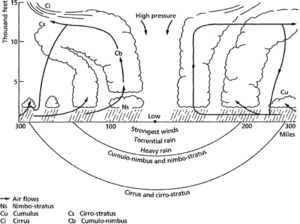A generally fairly small but intense, closed low-pressure system which develops over tropical oceans. It is circular in shape, comprising concentric rings of cumulus and cumulonimbus clouds, separated by bands of relatively clear sky in which air is subsiding. The ‘eye’ of the storm is fairly still and clear, with subsiding air that warms by compression; the warm air of the ‘eye’ is diagnostic of a tropical cyclone. Wind speeds of at least 33 m/s (force 12 on the Beaufort scale, 64 knots or more) define such storms and distinguish them from less intense systems, e.g. tropical depressions (of twice or more than twice the diameter) or tropical storms. The atmospheric pressure gradient in such cyclones commonly ranges from about 95 kPa at the centre to about 100 kPa at the margins and the core pressure defines the intensity of the system. See appendix c: Saffir-Simpson Hurricane Wind Scale.
Also known as a hurricane, or tropical storm, this is a disturbance about 650 km across, spinning about a central area of very low pressure, with winds over 140 km per hour. The violent winds are accompanied by towering clouds, some 4 000 m high, and by torrential rain; 150 mm (6 inches) frequently fall within the space of a few hours. There is, as yet, no complete understanding of how these storms develop; they can begin when air spreads out at high level above a newly formed disturbance at low levels. The upper-level outflow acts rather like a suction pump, drawing away the rising air at height and causing low-level air to be pulled in. The winds spiral into the centre because they are affected by the Earth’s rotation. The intense energy of these storms comes from the warmth of the tropical seas over which they develop. Thus, an extensive ocean area with surface temperatures of over 27 °C is necessary for hurricane formation.
The source regions must be far enough away from the equator—5° at least—for the Coriolis force to have an effect. The removal of air at height may be along the eastern limb of an upper air trough. Moisture-laden air spirals into the centre and rises, condensing to form a ring-like tower of cumulo-nimbus clouds. With this condensation, latent heat is released which causes the air to rise further and faster. The condensation also causes torrential rain. In the upper troposphere water droplets freeze and form cirrus clouds, which are thrown outwards by the spin of the storm.
At ground level, the temperature at the centre, or eye, of the storm is only slightly warmer than that at the margins, but, at heights of around 5 000 m, the centre can be 18 °C warmer than the margins. This warm core maintains the low pressure which drags in the winds. Senkbeil et al. (2011) Geog. Compass DOI: 10.1111/j.1749-8198.2011.00439.x review topics that summarize the current state of hurricane hazards in the USA, discussing wind and water hazards associated with land-falling tropical cyclones; and review societal impact such as mortality and morbidity, hazard perception, communication, evacuation, and risk. Ideas are presented that introduce suggestions on how possibly to change processes.
See tropical storm.

The structure of a tropical hurricane
- corresponding states
- corridor
- corridor dispersal route
- corrie
- corrigible
- corroboration
- corrosion
- corrupt
- corruption
- Corruption Perception Index
- corsair
- corset
- cortex
- Corti cell
- corticosteroid
- corticotrophin
- cortisol
- cortisone
- Cortés, Hernando (1485–1547)
- corundum
- Corvus
- corymb
- Corynexochida
- COS-B
- Cos-B